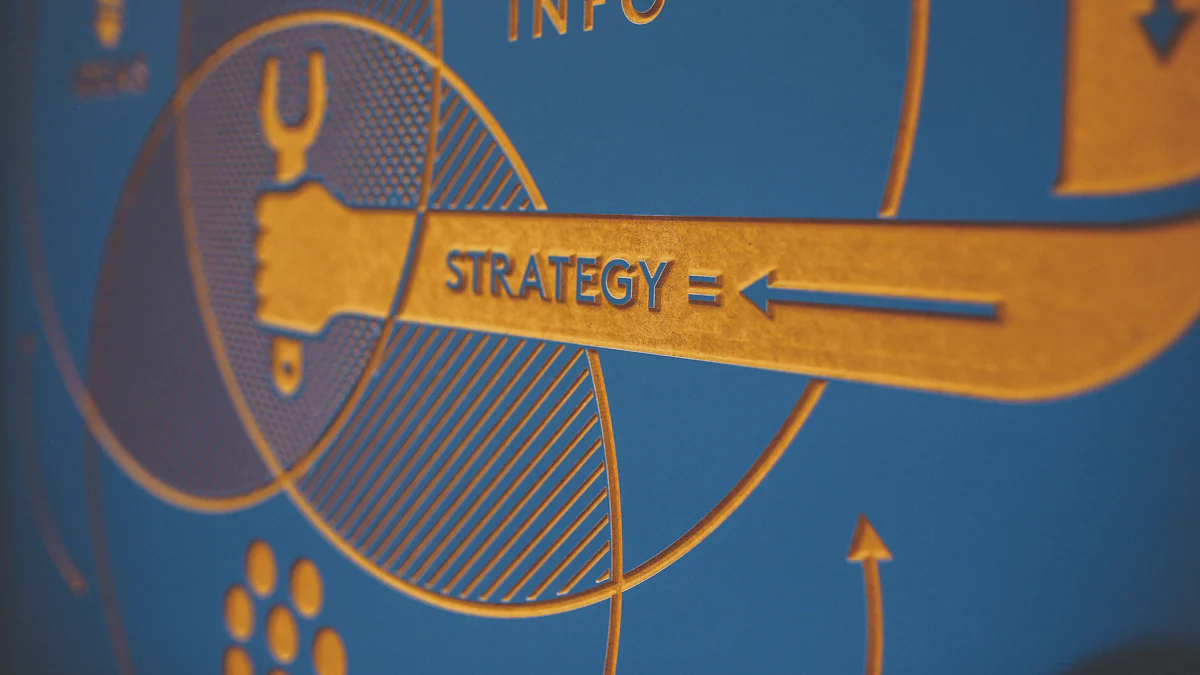How to Create a Customer Engagement Strategy Template

Customer engagement drives business success. Fully engaged customers contribute 23% more in revenue and profitability than average customers. A customer engagement strategy outlines methods to foster these valuable relationships. A customer engagement strategy template provides a structured approach, ensuring consistency and efficiency. Utilizing NewOaks AI and other customer engagement tools can enhance this process. Incorporating custom chatgpt solutions further personalizes interactions, boosting engagement.
Understanding Customer Engagement

Definition and Importance
What is Customer Engagement?
Customer engagement involves building relationships with customers at every touchpoint. This process includes interactions through various channels such as social media, email, and in-person communication. Businesses aim to create meaningful connections that foster loyalty and satisfaction.
Why is Customer Engagement Important?
Customer engagement plays a crucial role in business success. Engaged customers contribute significantly to revenue and profitability. According to a study by Paylode.com, fully engaged customers generate 23% more revenue compared to average customers. Effective engagement strategies also lead to long-term growth and higher spending, as noted by Hiverhq.com. Building strong relationships benefits both customers and businesses.
Key Elements of Customer Engagement
Communication
Communication forms the backbone of customer engagement. Businesses must maintain open and consistent dialogue with customers. This includes responding promptly to inquiries and providing clear information. Effective communication builds trust and enhances customer satisfaction.
Personalization
Personalization tailors interactions to meet individual customer needs. Businesses can achieve this by using data to understand customer preferences and behaviors. Personalized experiences make customers feel valued and understood. This approach strengthens relationships and encourages repeat business.
Feedback and Interaction
Feedback and interaction involve actively seeking customer opinions and engaging in two-way communication. Businesses should encourage customers to share their thoughts and experiences. This feedback provides valuable insights for improving products and services. Interaction fosters a sense of community and involvement, enhancing overall engagement.
Building the Foundation of Your Customer Engagement Strategy Template
Identifying Your Audience
Customer Segmentation
Customer segmentation divides a broad customer base into smaller, more manageable groups. These groups share similar characteristics such as demographics, buying behavior, or interests. Businesses can tailor marketing efforts to meet the specific needs of each segment. This approach enhances the effectiveness of customer engagement strategies.
Case Study: Black Diamond
Black Diamond, a retail company, improved personalization through effective customer segmentation. The company identified key customer segments and tailored marketing messages accordingly. This strategy led to increased acquisition and retention rates. Personalized communication resonated with customers, fostering loyalty and satisfaction.
Creating Customer Personas
Creating customer personas involves developing detailed profiles of ideal customers. These profiles include information such as age, gender, occupation, and preferences. Customer personas help businesses understand their audience on a deeper level. This understanding guides the development of targeted engagement tactics.
Steps to Create Customer Personas:
Conduct Research: Gather data from surveys, interviews, and analytics.
Identify Patterns: Look for common traits and behaviors among customers.
Develop Profiles: Create detailed descriptions of each persona.
Use Personas: Apply these profiles to tailor marketing and engagement strategies.
Setting Clear Objectives
Defining Goals
Defining goals provides direction for a customer engagement strategy template. Goals should be specific, measurable, achievable, relevant, and time-bound (SMART). Clear goals help businesses focus their efforts and measure success effectively.
Examples of Engagement Goals:
Increase customer retention by 15% within six months.
Improve customer satisfaction scores by 10% in the next quarter.
Boost social media engagement by 20% over the next year.
Aligning with Business Objectives
Aligning engagement goals with business objectives ensures that efforts contribute to overall success. Businesses should integrate customer engagement strategies into broader organizational plans. This alignment maximizes the impact of engagement initiatives.
Key Considerations:
Revenue Growth: How does the engagement strategy support sales targets?
Brand Loyalty: Will the strategy enhance customer loyalty and advocacy?
Market Expansion: Can the strategy help reach new customer segments?
Using customer engagement tools like CRM systems and custom ChatGPT solutions can streamline these processes. These tools provide valuable insights and automate interactions, making it easier to achieve defined goals.
Developing the Customer Engagement Strategy Template
Core Components of the Template
Introduction and Objectives
A well-crafted customer engagement strategy template begins with a clear introduction and objectives. The introduction should outline the purpose and importance of customer engagement. Objectives must be specific, measurable, achievable, relevant, and time-bound (SMART). Clear objectives provide direction and focus for the strategy.
Audience Analysis
Audience analysis is crucial for effective engagement. Businesses must understand their customers' demographics, preferences, and behaviors. This analysis involves segmenting customers into distinct groups and creating detailed personas. Accurate audience analysis ensures that engagement tactics resonate with the target audience.
Engagement Tactics
Engagement tactics form the core of the strategy. These tactics include personalized messaging, interactive content, and timely responses. Utilizing customer engagement tools like CRM software and marketing automation platforms can streamline these efforts. Effective tactics foster meaningful interactions and build strong relationships.
Measurement and Analysis
Measurement and analysis are essential for evaluating the success of the strategy. Key performance indicators (KPIs) such as customer satisfaction scores, retention rates, and social media engagement should be tracked. Analyzing this data helps businesses adjust their tactics and improve overall engagement.
Customer Engagement Tools and Technologies
CRM Systems
CRM systems handle contact and sales management, agent productivity, and customer relationships across the entire sales funnel. These systems provide valuable insights into customer behavior and preferences. Personalizing messaging to customers becomes easier with CRM platforms, increasing lead conversion.
Marketing Automation Tools
Marketing automation tools streamline processes by assigning and tracking tasks, sending alerts, and automating schedules. These tools help businesses deliver personalized, targeted content to customers. Automation ensures consistent and timely communication, enhancing customer engagement.
Social Media Platforms
Social media platforms play a vital role in customer engagement. Businesses can reach a wider audience and interact with customers in real-time. Prompt responses and engaging content on social media build a recognizable brand voice. This presence fosters loyalty and encourages customer advocacy.
Custom ChatGPT Solutions
Custom ChatGPT solutions offer personalized interactions and immediate responses. The New Oaks Chatbot can handle inquiries, provide information, and guide users through their journey. Advanced AI technology allows the chatbot to learn from interactions, continuously improving its effectiveness. Quick installation and seamless integration make it an ideal tool for enhancing customer engagement.
Implementing and Measuring Your Strategy

Actionable Steps for Implementation
Team Roles and Responsibilities
Assigning clear roles and responsibilities ensures smooth execution of the customer engagement strategy. Each team member must understand their specific tasks and how they contribute to the overall goals.
Project Manager: Oversees the entire strategy implementation. Ensures all tasks are completed on time.
Marketing Team: Develops and executes engagement tactics. Uses tools like CRM systems and marketing automation platforms.
Customer Support Team: Handles direct interactions with customers. Provides feedback to improve engagement tactics.
Data Analyst: Monitors key performance indicators (KPIs). Analyzes data to measure success and suggest improvements.
Timeline and Milestones
Establishing a timeline with clear milestones helps track progress and maintain momentum. Each phase of the strategy should have specific deadlines to ensure timely completion.
Initial Setup (Week 1-2): Install and configure necessary tools. Train team members on their roles.
Audience Analysis (Week 3-4): Segment customers and create detailed personas. Use this information to tailor engagement tactics.
Tactic Development (Week 5-6): Develop personalized messaging and interactive content. Plan social media campaigns.
Implementation (Week 7-8): Launch engagement tactics. Monitor initial responses and make adjustments as needed.
Ongoing Monitoring (Week 9+): Continuously track KPIs and customer feedback. Adjust strategies based on data analysis.
Measuring Success
Key Performance Indicators (KPIs)
Tracking KPIs provides a clear picture of the strategy's effectiveness. These metrics help identify areas of success and opportunities for improvement.
Customer Satisfaction Scores: Measure customer happiness with products and services. High scores indicate successful engagement.
Retention Rates: Track the percentage of returning customers. Higher retention rates suggest strong customer loyalty.
Social Media Engagement: Monitor likes, shares, comments, and followers. Increased engagement reflects effective social media tactics.
Conversion Rates: Measure the percentage of engaged customers who make a purchase. Higher conversion rates indicate successful engagement tactics.
Analyzing Customer Feedback
Customer feedback offers valuable insights into the effectiveness of engagement strategies. Actively seek opinions through surveys, reviews, and direct interactions.
"Improving customer loyalty, reducing churn rates, increasing word-of-mouth recommendations, enhancing brand reputation" - Survey Focus
Use feedback to identify strengths and weaknesses in current tactics. Adjust strategies based on this information to better meet customer needs.
Adjusting the Strategy Based on Data
Regularly reviewing data ensures the strategy remains effective and relevant. Analyze KPIs and customer feedback to make informed adjustments.
Identify Trends: Look for patterns in customer behavior and preferences. Use these insights to refine engagement tactics.
Test New Approaches: Experiment with different tactics to see what resonates best with customers. Continuously improve based on results.
Monitor Competitors: Keep an eye on industry trends and competitor strategies. Adapt successful tactics to enhance your own engagement efforts.
By following these steps, businesses can implement a robust customer engagement strategy. Utilizing tools like the New Oaks Chatbot can further enhance interactions and drive success.
A customer engagement strategy remains essential for business success. A structured template ensures consistency and efficiency in executing this strategy. Start creating a customer engagement strategy template today to enhance interactions and foster loyalty.
See Also
Exploring Intercom Principles: Creating a Successful Customer Journey
Transforming Customer Interaction through Intercom Integrations and AI Automation
Optimizing Website Interaction with AI Integration Before Conversations
Innovating Customer Onboarding using Intercom CRM
Modernize Customer Interaction and Scheduling with NewOaks Chatbot Platform | Intercom Rival

